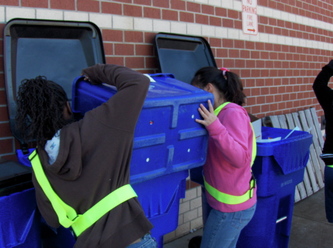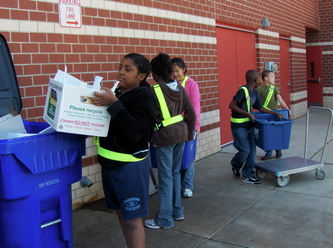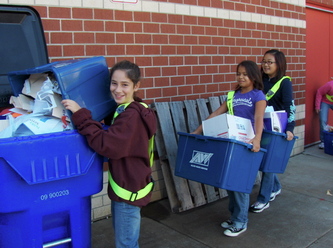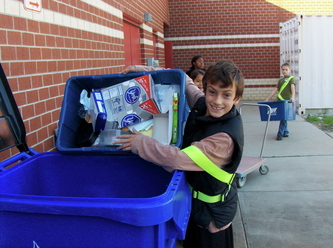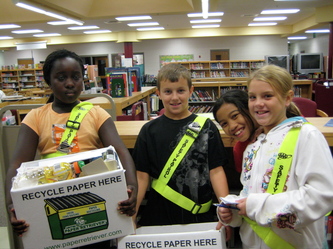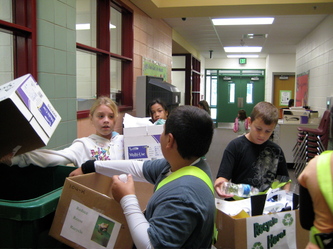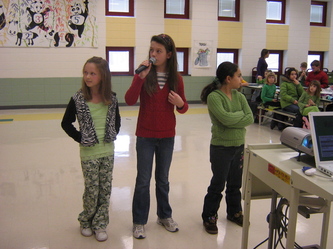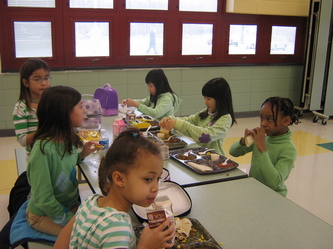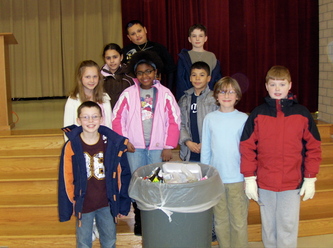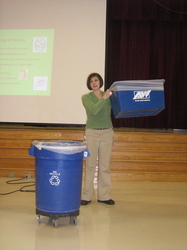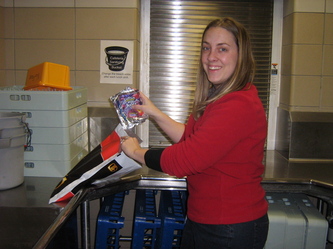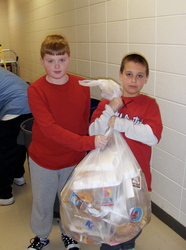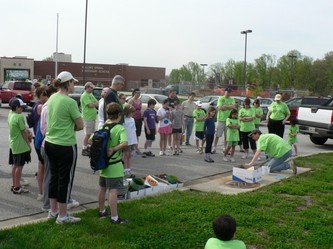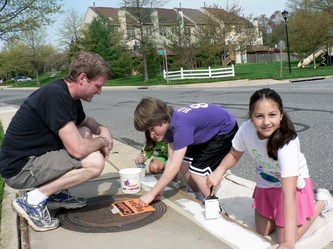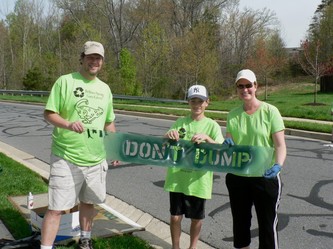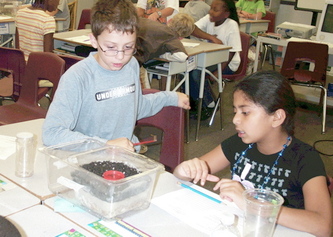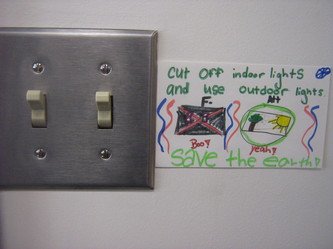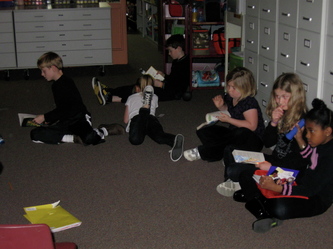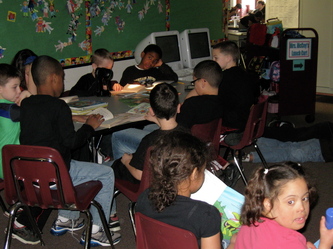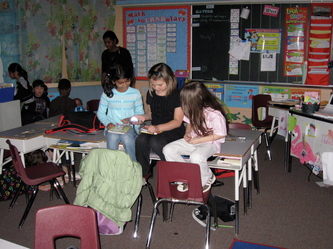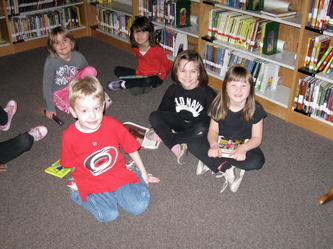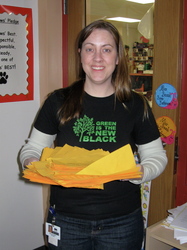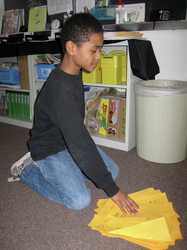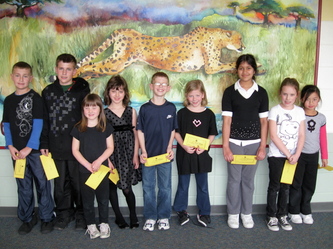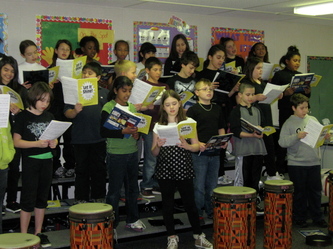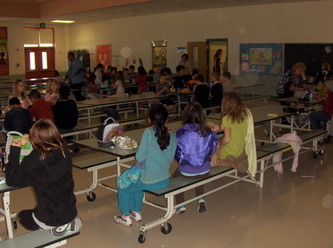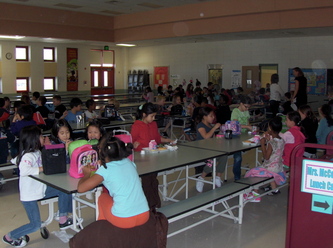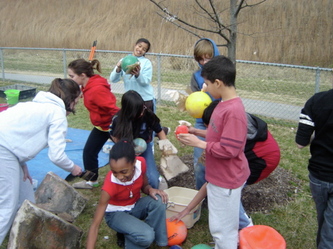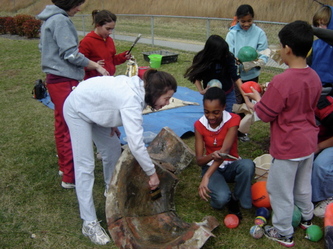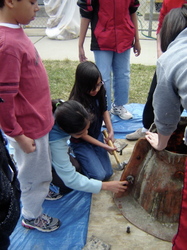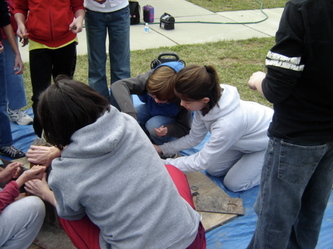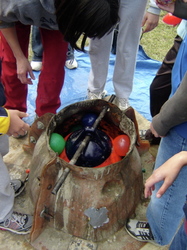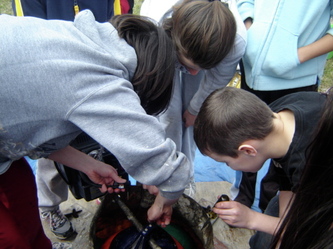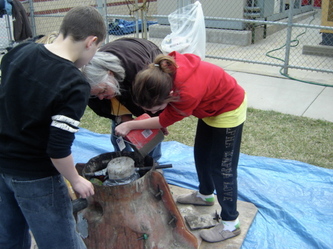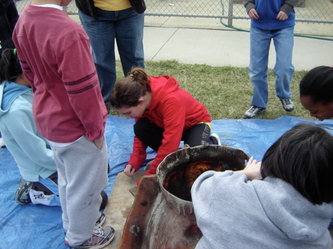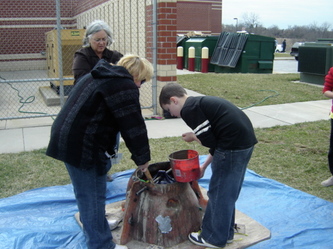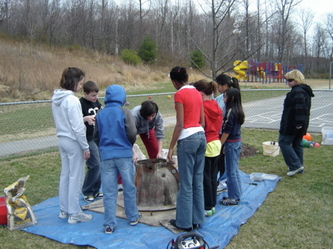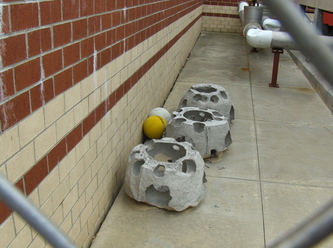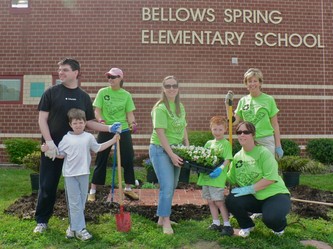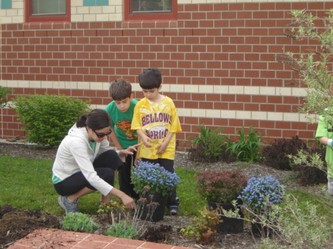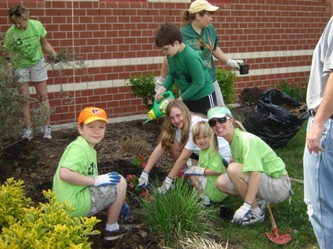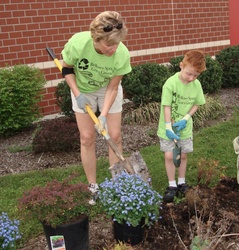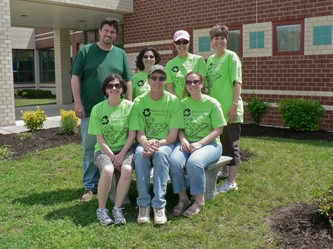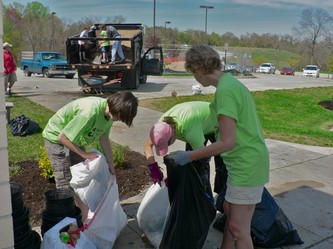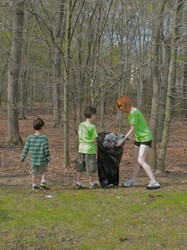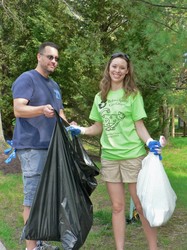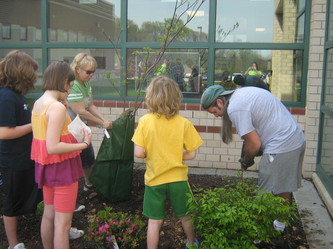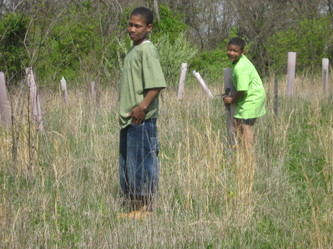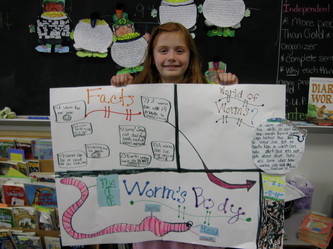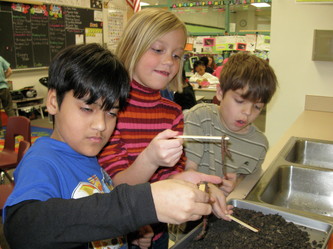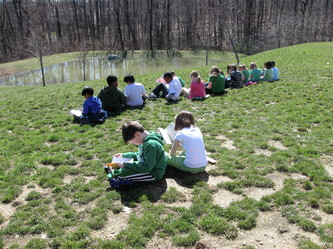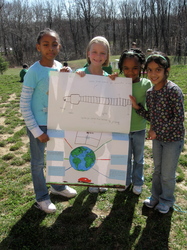Being Green at BSES
Solid Waste Reduction
Recycle Safeties

What an important job this group of kids has taken on for the year. They are responsible for recycling in the whole school!!! During the school year of 2008-2009, each of the classrooms were given a recycle bin so that they could begin to separate their things. Last year, the classrooms concentrated on recycling paper since our school participated in the Abitibi Recycling. But this year we recycle it all! Howard County currently allows us to mix everything and this has made it much easier to recycle in the classrooms. Students were educated on what could go in their bins and are now vigilant in their efforts. Each morning these safeties meet Mrs. English and they cart every team's recycling out to the recycle bins by the cafeteria. In order to become a safety, fifth grade students have to apply and fill out an application as to why they would be good for this role. These kids are role models for our school.
| abitibi.pdf |
Cafeteria Recycling
The fifth grade Green Team had a big project on their hands! Making the cafeteria more “green” by reducing waste and taking data to see how each grade improves is not an easy task. The green team started off by taking baseline data and weighing the amount of trash each lunch shift produced. Here are the results:
Kindergarten: 29 lbs, First Grade: 36 lbs, Second Grade: 28.5 lbs,
Third Grade: 32 lbs, Fourth Grade: 26 lbs, Fifth Grade: 29 lbs.
That was a total of 180.5 lbs a day and an average of 902.5 lbs a week just from the cafeteria; now that’s a lot of trash!! With all the staff and students wearing green to show their support, the Green Team made presentations to each grade about how recycling in the cafeteria would work. The school officially started recycling in the cafeteria during the week of January 12, 2009, and we saw amazing results. The Green Team weighed the trash on Trash Free Tuesdays for two months to see if the trash was actually reducing. Graphs in the cafeteria let the grades see the results of the diminishing trash. This was something for all the kids to be proud about.
Kindergarten: 29 lbs, First Grade: 36 lbs, Second Grade: 28.5 lbs,
Third Grade: 32 lbs, Fourth Grade: 26 lbs, Fifth Grade: 29 lbs.
That was a total of 180.5 lbs a day and an average of 902.5 lbs a week just from the cafeteria; now that’s a lot of trash!! With all the staff and students wearing green to show their support, the Green Team made presentations to each grade about how recycling in the cafeteria would work. The school officially started recycling in the cafeteria during the week of January 12, 2009, and we saw amazing results. The Green Team weighed the trash on Trash Free Tuesdays for two months to see if the trash was actually reducing. Graphs in the cafeteria let the grades see the results of the diminishing trash. This was something for all the kids to be proud about.
School Communication
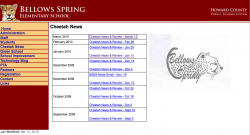
To help cut down on paper usage, our school has changed the method for delivering the bi-weekly school newsletter, "Cheetah News & Review." Instead of making over 800 paper copies every other week, we now publish the newsletter on the school website. In addition, urgent notices that need to be communicated to parents in a timely fashion, which used to be distributed with paper notices, are now sent out through email. We estimate this saves over 400 pounds of paper each school year.
Staff Gifts

Over the past couple of years, our administration has shown their support of our green initiative by encouraging the staff to live green. At the beginning of the year, staff have been given reusable bags and aluminum water bottles with Bellows Spring printed on them. When opening our staff lounge refrigerators, Bellows Spring lunch boxes are abundant. This promotes another way the staff shows their "green" side - by packing their lunches in a reusable bag.
TerraCycle

TerraCycle is a company that has taken a twist on traditional recycling, and has turned it into "upcycling." In this concept, a product that is typically thrown in the trash is able to be used again; however, it often maintains its original packaging. We encouraged students to upcycle their Capri Sun drink pouches. These pouches are then turned into pencil cases or backpacks.
Cartridges For Kids
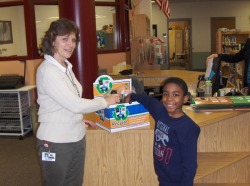
Although our school does a good job of being thoughtful about what does and does not need to be printed, we do go through a lot of printer cartridges. To help cut down on the environmental impact of throwing all these print cartridges away, we participate in cartridge recycling program. In cooperation with the Cartridges for Kids program, our school receives money for sending in printer cartridges, old cell phones, and other electronics. We reinvest the money we receive from the program to our green school fund. Our community also participates in this program by sending in things from their own homes to recycle. There is a bi-weekly reminder in the school newsletter to remind families to continue to contribute their ink cartridges and cell phones.
Technology Use
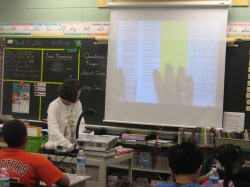
Through the generosity of our media specialists, our school has been able to purchase 15 document cameras over the last two years, using funds from our annual Book Fair. In addition, we are close to having one LCD projector for every classroom teacher. This technology has allowed teachers to enhance their instructional practices while cutting down on the amount of paper handouts that need to be made. Our school district has also provided a laptop for each teacher in the building. This has had a great impact on not only enhancing integrating technology into instruction, but also making communication among teachers and the community virtually paperless.
Water Conservation and Pollution
Storm Drain Painting
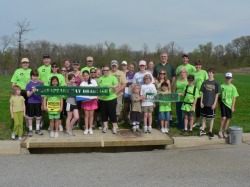
As part of the Celebrate Green Day, we decided to provide our community with a reminder of where our water ends up, which is the bay! We consulted neighboring community associations for their consent to paint the most visible storm drains in the area. In order to fund this endeavor, we received a grant from the Chesapeake Bay Trust. One of our dedicated parents took on the job of teaching the group how the process works and then they were off to paint the neighborhood drains. This part of our community event was very successful. With about 50 drains painted in the area, our school now feels that we are a part of helping the bay to stay clean.
| woodland_village_hoa_-_storm_drain_painting.pdf |
Buffers

In science, fifth grade students learn about the features of the land that surrounds water. They worked in groups to construct a model of a watershed in a large pan. By adding water and then "pollutants," they are able to see how water is affected by what is happening on the land around it. Group discussions take place to help the students relate their classroom experiences to real world situations and problems. They understand that the pollutants they add are like fertilizers, oils, paints, run off, etc. in the area. Through this lab, they are able to grasp the understanding of the importance to take care of our waters and that what we do in our yards affects surrounding areas.
| buffers2.pdf |
Aquifer Education
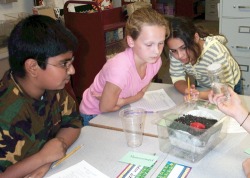
Building an Aquifer October 10, 2008
Students in Mrs. Rudo's homeroom built a model aquifer. The model included different layers (rocks, gravel, sand, dirt) and allowed the students to watch water move through an aquifer. They created "rain" and then monitored the path of the water. Most of the water got "trapped" between the particles in each layer, although some of the water immediately became "run-off" and ended up in the model pond. Some of the water moved completely through the aquifer and came out the bottom once the ground was saturated. Students have learned that an aquifer is a place where underground water is stored. When it rains, water soaks into the ground and becomes part of the groundwater.
"It was fun to see the water go through all the different substances." MW fifth grader
Students in Mrs. Rudo's homeroom built a model aquifer. The model included different layers (rocks, gravel, sand, dirt) and allowed the students to watch water move through an aquifer. They created "rain" and then monitored the path of the water. Most of the water got "trapped" between the particles in each layer, although some of the water immediately became "run-off" and ended up in the model pond. Some of the water moved completely through the aquifer and came out the bottom once the ground was saturated. Students have learned that an aquifer is a place where underground water is stored. When it rains, water soaks into the ground and becomes part of the groundwater.
"It was fun to see the water go through all the different substances." MW fifth grader
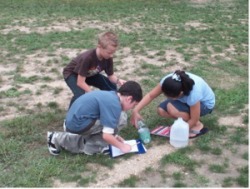
Building and Polluting an Aquifer - September 4, 2008
Students in Ms. Thompson's homeroom built a model aquifer in a plastic flex tank. They added water to the model to watch how water moves through the ground after it rains. They also included a “pond” on the surface to see how the water that doesn’t soak in will become run-off. The next day, students “polluted” their model with water that was colored with food coloring. They examined the difference between the “soak in” that drained through the model (less polluted) than the “run off” that went straight to the pond. Very polluted.
Students in Ms. Thompson's homeroom built a model aquifer in a plastic flex tank. They added water to the model to watch how water moves through the ground after it rains. They also included a “pond” on the surface to see how the water that doesn’t soak in will become run-off. The next day, students “polluted” their model with water that was colored with food coloring. They examined the difference between the “soak in” that drained through the model (less polluted) than the “run off” that went straight to the pond. Very polluted.
| aquifer.pdf |
Energy Conservation
Energy Week
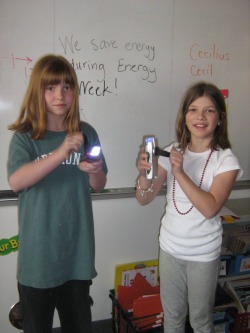
Throughout Energy Week, all students learned about and participated in energy conservation activities. The Green Team's goal was to raise awareness of energy use and ways to help reduce consumption both in our school and at home. Through the e-school newsletter, families were informed of the week and encouraged to save energy by talking to their children about energy use in their homes. They were further encouraged to come up with a plan of what they could do to reduce their consumption. Some simple tips for the week were:
Daily morning announcements started us off on the right foot and each day of the week had an activity planned by the Green Team. Home energy audits were sent home with the youngest or only student as a motivating activity for families to complete at home. Students were introduced to the idea of energy conservation in all classrooms. The Blue Sky Puppet Theater gave a presentation to the students. The theme of the presentation was on energy conservation and ways to reduce energy output.
Mid-week students enjoyed a more quiet, peaceful atmosphere during a natural light lunch. Many of our para-educators said they would like to do natural light lunches more often. In classrooms throughout the week, students read informative magazines that were ordered through Baltimore Gas and Electric. Every student was able to take the booklets home and share what they learned with their families.
Finally, on Friday, as a way to celebrate our learning and to use less electricity in the school building, all students wore black and participated in "black-out" reading. They were encouraged to bring in a flashlight and a good book and the school turned off all lights for 15 minutes. All was quiet and dark in the building!
Almost 200 students completed a home energy audit. All families who sent in their completed audit were entered in a drawing for a gift certificate to our school book cart. Students helped in selecting ten winners which were announced at the conclusion of "black-out" reading. Overall, the week was very successful and fun.
Listed below are a few of the activities that were completed during each grade level for Energy Conservation Week.
- Eat dinner outside or with natural light
- Pack a waste free lunch
- Turn off the T.V. and read, go outside, or play a game as a family
- Make a pact to use less lights than usual every evening
- Turn off those computers when they are not in use
Daily morning announcements started us off on the right foot and each day of the week had an activity planned by the Green Team. Home energy audits were sent home with the youngest or only student as a motivating activity for families to complete at home. Students were introduced to the idea of energy conservation in all classrooms. The Blue Sky Puppet Theater gave a presentation to the students. The theme of the presentation was on energy conservation and ways to reduce energy output.
Mid-week students enjoyed a more quiet, peaceful atmosphere during a natural light lunch. Many of our para-educators said they would like to do natural light lunches more often. In classrooms throughout the week, students read informative magazines that were ordered through Baltimore Gas and Electric. Every student was able to take the booklets home and share what they learned with their families.
Finally, on Friday, as a way to celebrate our learning and to use less electricity in the school building, all students wore black and participated in "black-out" reading. They were encouraged to bring in a flashlight and a good book and the school turned off all lights for 15 minutes. All was quiet and dark in the building!
Almost 200 students completed a home energy audit. All families who sent in their completed audit were entered in a drawing for a gift certificate to our school book cart. Students helped in selecting ten winners which were announced at the conclusion of "black-out" reading. Overall, the week was very successful and fun.
Listed below are a few of the activities that were completed during each grade level for Energy Conservation Week.
- Kindergarten students used white boards instead of using paper.
- First grade students became informed about ways that they could save energy in their homes and school.
- Second grade students used one computer instead of two and worked in partial lighting.
- Third grade students completed several of their lessons outdoors to conserve electricity.
- Fourth grade students wrote informational and persuasive letters about energy conservation at home.
- Fifth grade students made pinwheels to model renewable energy and compared the rotational speeds of large and small wheels.
| energyaudit.pdf |
| energy_morning_work.pdf |
Light Reminders
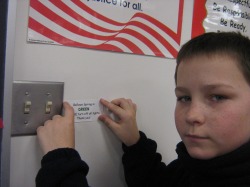
Our school secretary, Mrs. Ginny Stickles, made reminder labels for all staff to turn off the lights when not in use. The reminders read, "Bellows Spring is GREEN. PLEASE turn off all lights. Thank you!" Several students helped to hang these reminders around the building, and they are now in staff restrooms, team closets, the staff lunchroom and many classrooms.
Energy Monitors
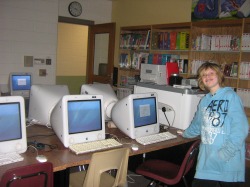
Several fifth grade students are responsible for turning off computers at the end of the day. These "energy monitors" turn off all the computers in our two computer labs, and they also go to every classroom in our building at the end of the day to reduce the amount of energy that is being consumed by our school.
Motion Monitors
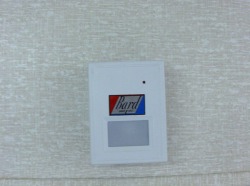
All seven of our portables use energy efficient technology. These "motion sensors" recognize the schedule of the teacher and the heating and/or air units come on and go off accordingly. This is more energy efficient because the systems are not being used in the evening and on the weekends while no one is using them. We all know that portables are not the best energy savers so every little bit counts when it comes to heating and cooling these classrooms.
Habitat Restoration
Oyster Reef Restoration
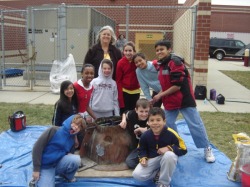
Fourth and fifth grade students participated in a seminar to learn about the Chesapeake Bay and what an important part oysters play in keeping this important estuary clean. Oysters, we couldn't do it with out them! They act as a natural filter to clean the water during their breathing process. Over harvesting, pollution, and disease are some of the reasons why the oyster populations are in trouble. Cleaning the bay used to be done in a few days in the past; now it takes a whole year to clean the same amount of water. With the oyster population being about 1-2% of what it used to be, the other animals in the bay struggle in a home that is not as clean. After the students learned some background about the bay and how we could help by creating homes for the oysters, we got right to work creating three oyster orbs! We are glad we could be a part of making a difference. Working with concrete was really cool too:) Students were able to share their new knowledge with the community at our Enrichment Fair as well.
Some quotes from the students' experience:
"I liked the oyster project because it's really fun to know the problems the oysters are having and how to help. I liked making the oyster ball and knowing that we can help. I learned a lot of things especially that the oysters help filter the water for the animals." HS, fourth grader
"I learned that oysters filter the bay when they breathe. I knew many creatures in the bay were dying so I was glad to help create a home for them, especially for the ones that clean our water. Also this project was fun when we mixed the concrete." DK, fifth grader
"This is so meaningful to me because I am helping the Earth and environment. That is one of my life long dreams. I liked mixing the concrete mixture. I learned how the project will help the bay." AB, fifth grader
Some quotes from the students' experience:
"I liked the oyster project because it's really fun to know the problems the oysters are having and how to help. I liked making the oyster ball and knowing that we can help. I learned a lot of things especially that the oysters help filter the water for the animals." HS, fourth grader
"I learned that oysters filter the bay when they breathe. I knew many creatures in the bay were dying so I was glad to help create a home for them, especially for the ones that clean our water. Also this project was fun when we mixed the concrete." DK, fifth grader
"This is so meaningful to me because I am helping the Earth and environment. That is one of my life long dreams. I liked mixing the concrete mixture. I learned how the project will help the bay." AB, fifth grader
Celebrate Green
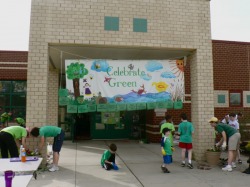
The “Celebrate Green” event at Bellows Spring was a big success. Dedicated staff, parents, students, and community members were all a part of making this day the great success that it was. The idea was cultivated by a committee of staff and parents to create a day where our community could come together, show our dedication to being green, give our time to make our surroundings better, and demonstrate that Bellows Spring can give back. The committee worked very hard to put together a day that was rewarding and fun. The coordination of cleaning the community, painting storm drains, and landscaping the school yard was met with enthusiasm. Volunteer families and staff showed up in the morning to some breakfast treats and juice while they listened to a short presentation about the day’s events. As the volunteers assembled that morning in the cafeteria, the sea of green shirts from our school wide t-shirt contest were eye catching. This set the tone as a community that works together. A representative from the Office of Environmental Sustainability and Department of Planning and Zoning discussed what is recyclable and non-recyclable in Howard County so that the community gained awareness both for the day and for future use at home. Families were broken into three groups: storm drain stenciling, landscaping, and community clean up. We had breakout sessions for everyone to get specific directions about their tasks and then they were on their way. It was great to see the school grounds transformed right before our eyes, as the volunteers were busy planting/moving new and old shrubs. The front of the school is now so much more inviting to students, staff, and visitors. You can tell Bellows Spring takes pride in their image to the community. Five dedicated teams painted storm drains on the main streets of two neighborhoods. This brightens up the streets and makes the community think twice about the Bay. As the clean up group collected both trash and recyclable items, the bags were placed along the main road for our truck to come by and bring them back to school. Some of the volunteers decided to tackle cleaning up an area near the entrance to our school where trees had been planted by the county, but never grew. There was a whole truck load of plastic tubing removed; not only is it better for the environment that those are gone, but it looks much better as well. Our day culminated with a group picture and a picnic to celebrate a job well done. All we continued to hear throughout the day was “When we do this next year…”, we’ll take that as a good sign that the community felt good about their day.
| celebrate_green.pdf |
| community_day_pres..ppt |
| community_project.doc |
| final_report_9871.doc |
2nd Grade Worms
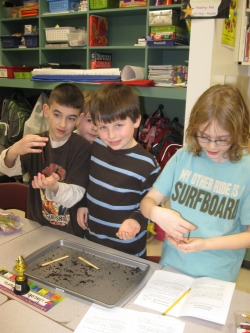
Wonderful Worms!
Mrs. Feldman’s second grade class
My second grade students and I worked together on a weeklong language arts and science integration unit on worms. I chose worms as a subject because they are a perfect way for students to observe and learn about worms: Earth’s greatest natural recyclers. While the students learned a lot about recycling, healthy soil, and ecology in this unit, more importantly, this unit gave students the opportunity to reflect on the idea that even things that are small, and seemingly insignificant, can still be very important. (A concept that young children embrace!) Hopefully, planting this idea at an early age will help children consider how their actions affect not only themselves, but also our entire ecosystem.
Activities:
Students observed the external anatomy of worms and brainstormed how worms’ physical adaptations enable them to lead a burrowing life.
Students learned about worm’s habitat and how we can help worms do their job by composting leaves, grass clippings, and by starting compost piles. We learned how worms’ castings fertilize soil naturally and how some farm chemicals can hurt worms.
We made a worm bin and students saw how worm tunnels loosen and aerate the soil making it easier for plants to grow strong, deep roots. Plants with deep roots need less water. Students also observed how worm tunnels work to capture rainwater and quickly channel the water deep to plants’ roots preventing topsoil erosion while making stronger, more productive plants and crops. Students also observed how worms pull decaying matter under the soil.
We read fiction and nonfiction books to learn about worms and students completed a Worm Journal to make predictions, record data, and write observations.
Students then extended their understanding about worms to write fiction about worms. We had a wild, wonderful, and wormy week!
Mrs. Feldman’s second grade class
My second grade students and I worked together on a weeklong language arts and science integration unit on worms. I chose worms as a subject because they are a perfect way for students to observe and learn about worms: Earth’s greatest natural recyclers. While the students learned a lot about recycling, healthy soil, and ecology in this unit, more importantly, this unit gave students the opportunity to reflect on the idea that even things that are small, and seemingly insignificant, can still be very important. (A concept that young children embrace!) Hopefully, planting this idea at an early age will help children consider how their actions affect not only themselves, but also our entire ecosystem.
Activities:
Students observed the external anatomy of worms and brainstormed how worms’ physical adaptations enable them to lead a burrowing life.
Students learned about worm’s habitat and how we can help worms do their job by composting leaves, grass clippings, and by starting compost piles. We learned how worms’ castings fertilize soil naturally and how some farm chemicals can hurt worms.
We made a worm bin and students saw how worm tunnels loosen and aerate the soil making it easier for plants to grow strong, deep roots. Plants with deep roots need less water. Students also observed how worm tunnels work to capture rainwater and quickly channel the water deep to plants’ roots preventing topsoil erosion while making stronger, more productive plants and crops. Students also observed how worms pull decaying matter under the soil.
We read fiction and nonfiction books to learn about worms and students completed a Worm Journal to make predictions, record data, and write observations.
Students then extended their understanding about worms to write fiction about worms. We had a wild, wonderful, and wormy week!
| worm_book.pdf |
| maddisen_worm_story.pdf |
| maddisen_story_pg2.pdf |
No Mow Zone
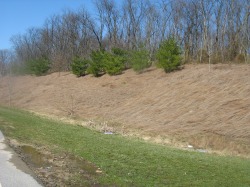
No-mow zones are areas that are allowed to naturally vegetate and that are not cut the way traditional lawns are maintained. The no-mow zone provides habitats for wildlife like birds, frogs, butterflies and dragonflies. By leaving riparian vegetation intact this allows tall grasses with deep roots to become established. The entire back field of our school is an established no-mow zone.
